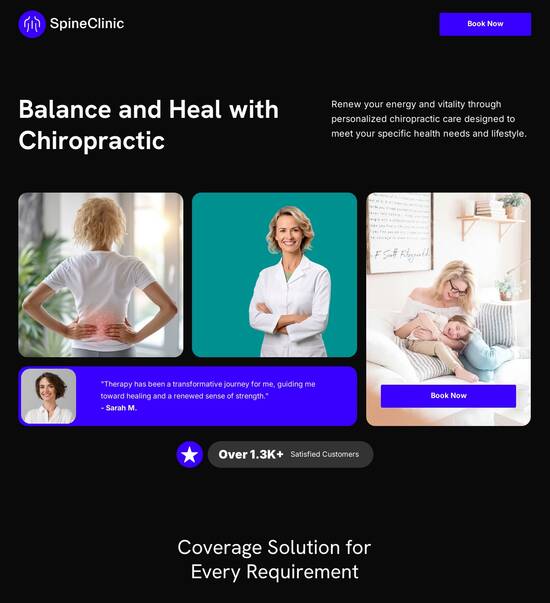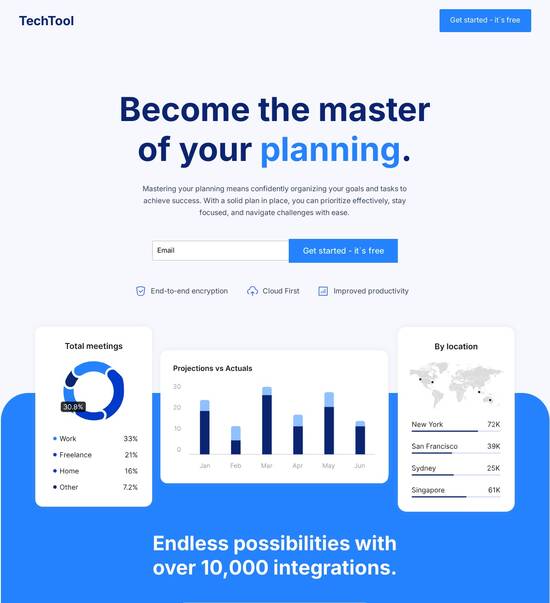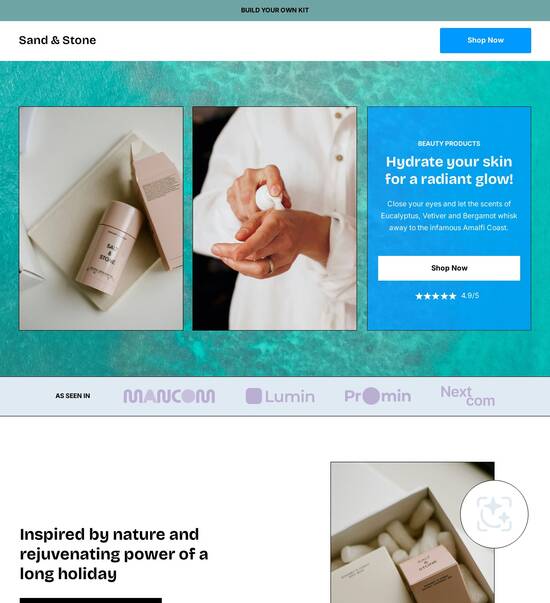
Informative resources page template
Explore Similar TemplatesAbout template
Unleash your creativity with the informative resources page template. Try Instapage today.
Recommended templates

Easy to build without coding
With the intuitive drag-and-drop builder, anyone on your team can create high-converting pages without any knowledge of code or design. Make enhancements to your landing page with custom widgets using Javascript, HTML/CSS, or third-party scripts.

Multiple layouts for any industry and goal
Select from 500+ landing page layouts built to boost conversions across industry-specific scenarios. Customize them by adjusting fonts, adding images, and generating on-brand content with the AI assistant. Quickly scale with Instablocks® and Global Blocks that you can save, reuse, and update globally.

Loads fast and looks polished on any device
Every template is responsive, which means they present professionally on any device and load blazingly fast with our Thor Render Engine. You can also power them up with Google AMP technology to deliver an unparalleled mobile experience and drive higher conversions.

Robust analytics & experimentation
Get real-time updates and reporting across all your devices, showing the number of visitors, conversions, cost-per-visitor, and cost-per-lead. Launch AI-powered experiments, run A/B tests, and use heatmaps to analyze user behavior, then optimize your landing page to maximize conversions.







Easy to build without coding
With the intuitive drag-and-drop builder, anyone on your team can create high-converting pages without any knowledge of code or design. Make enhancements to your landing page with custom widgets using Javascript, HTML/CSS, or third-party scripts.
Multiple layouts for any industry and goal
Select from 500+ landing page layouts built to boost conversions across industry-specific scenarios. Customize them by adjusting fonts, adding images, and generating on-brand content with the AI assistant. Quickly scale with Instablocks® and Global Blocks that you can save, reuse, and update globally.
Loads fast and looks polished on any device
Every template is responsive, which means they present professionally on any device and load blazingly fast with our Thor Render Engine.
Robust analytics & experimentation
Get real-time updates and reporting across all your devices, showing the number of visitors, conversions, cost-per-visitor, and cost-per-lead. Launch AI-powered experiments, run A/B tests, and use heatmaps to analyze user behavior, then optimize your landing page to maximize conversions.
All the features you need to build resource page example
Explore more featuresLearn how to build resource page template
Frequently asked questions about resource page design
Leading the way in building high-performing landing pages





Resources page design: Your ultimate how-to guide
In the competitive landscape of digital marketing, creating high-converting landing pages is crucial for maximizing your return on investment. Instapage stands out as the most powerful landing page and conversion rate optimization (CRO) platform designed to help marketers effortlessly accelerate, optimize, and scale their campaigns. This guide will walk you through the essential steps to leverage Instapage’s features effectively.
Understanding the benefits of using Instapage for your campaigns
Instapage provides marketers with an all-in-one solution, ensuring that anyone, regardless of budget or team size, can create stunning landing pages that drive results. This platform is particularly beneficial for businesses within the marketing and advertising, tech, education, and financial sectors looking to enhance their digital strategies.
- Access to over 100 high-converting templates: These ready-to-use designs help you save time and maintain effectiveness in capturing leads.
- Built-in A/B testing functionality: Experiment with different designs and content to understand what resonates best with your audience and drive higher conversions.
- Personalization features: Customize content for distinct audience segments, enhancing user experience and engagement.
Step 1: Creating your first landing page with Instapage
To create an effective landing page using Instapage, follow these essential steps:
- Choose a template: Start with one of the pre-built templates that aligns with your campaign's goals. This saves time and helps ensure best practices are followed.
- Customize your content: Utilize the drag-and-drop builder to modify copy, images, and lead generation elements that resonate with your target audience.
- Preview and publish: Use the preview feature to see how the page looks on different devices before setting it live.
Step 2: Optimize your landing page for conversions
Optimization is key to ensuring your landing page performs well. Here are ways to enhance your page’s effectiveness:
- Implement heatmaps for insights: Understanding how visitors interact with your page through heatmaps can help you identify areas that need improvement.
- Run A/B tests: Regular testing helps you compare various elements of your page, like headlines or images, to find the most effective options.
- Utilize analytics dashboards: Assess performance over time to adjust your strategies based on real-time data.
Step 3: Collaborate and iterate for better results
Effective collaboration can significantly speed up your page production. Consider these strategies:
- Use real-time page editing: Allow team members to make instant edits and provide feedback to streamline the review process.
- Share pages securely: Collaborate with external stakeholders by sharing access to your pages without compromising security.
- Track feedback: Maintain organized feedback loops to enhance iterations based on team insights.
By following these steps, you'll create landing pages that are not only visually appealing but also optimized for maximum conversion rates.
Ready to take your landing page and conversion strategies to the next level? Start with Instapage today and watch your digital campaigns soar.
People also ask about resources page template
Informative Resources Page Template: Optimizing Your Digital Strategy
Understanding informative resource page templates
To begin with, informative resource page templates serve as pivotal tools in digital marketing strategies. These pages provide users with a curated collection of information that addresses specific topics or issues. Unlike typical content pages, a resource page acts as a centralized hub that offers valuable external and internal links, making it easier for users to navigate relevant information quickly.
Templates specifically refer to the pre-designed formats used to create these resource pages. When it comes to landing page optimization, templates save time and ensure consistency in design and functionality. A well-structured template ensures that information is organized logically, facilitating a smoother user experience, which is crucial for retaining visitors on your site.
The benefits of maintaining a well-organized informative resource page are numerous. It not only enhances user experience but also lays the groundwork for SEO, helping your site rank better in search engines. Moreover, a clearly structured resource page can guide users seamlessly to the information they seek, ultimately leading to increased engagement and time spent on your page.
The role of informative resource pages in business strategy
Informative resource pages play a vital role in enhancing a brand's credibility and authority. By providing valuable content and resources, businesses can position themselves as thought leaders in their respective industries. This authoritative presence builds trust among users, inviting them to engage with the brand on a deeper level.
Additionally, these pages support content marketing efforts by curating useful resources that can be shared across various platforms. For instance, blogs, social media, and newsletters can link back to resource pages, further disseminating valuable information while driving traffic to your site.
Moreover, informative resource pages streamline the customer decision-making process. When potential customers have access to high-quality, curated information, their path to making a purchase is much clearer, resulting in higher conversion rates. Users appreciate going to one destination for multiple solutions, and businesses that provide this convenience can greatly improve customer satisfaction.
Key features of informative resource page templates
One of the primary features of informative resource page templates is logo integration. Including your brand's logo prominently not only ensures brand visibility but also reinforces brand identity. Users are often more inclined to trust brands that maintain consistent visual branding across their content.
Logo placement: Ensure that your logo is positioned distinctly, ideally at the top left of the page, as this is where eyes typically land first.
Best practices for size: A well-sized logo should be noticeable but not overpower the page's content—aim for clarity and proportionality.
Case studies: Look into how prominent brands have successfully employed logo placement on their resource pages to enhance user trust and engagement.
Another impactful feature is corner branding, which adds subtle yet powerful branding elements to a page. This might include small logos or brand colors placed in corners or margins, contributing to a cohesive design without being intrusive.
Definition: Corner branding refers to brand-marketing elements placed discreetly at the corners of a page.
Placement strategy: This should be strategically executed to ensure visibility without distracting users from the primary content.
Successful examples: Investigate various brands that have utilized corner branding effectively to reinforce their branding while maintaining a user-friendly design.
Exploration of page templates and their varieties
When considering page templates, it's crucial to recognize the various types offered. Standard templates provide a solid foundation for most businesses, making them easy to use but sometimes limiting in customizability. They can be useful for businesses that seek efficiency without needing extensive design alterations.
Pros of standard templates: Quick setup, intuitive layouts, and pre-built functionalities simplify the crafting of resource pages.
Cons: They may lack the distinctiveness that a custom template can provide, making brand identity harder to convey.
Customizable templates are ideal for businesses that want a unique look—these can be tailored to align with specific brand aesthetics and objectives.
Niche-specific templates address unique industry requirements and allow businesses to highlight their expertise. Creating a specialized resource page template can enhance user engagement by providing relevant information tailored to that audience's needs.
In addition to selecting the right template, a well-structured site plan significantly benefits user navigation. An effective site plan includes clear navigation, a logical hierarchy, and accessibility features that ensure all users can find information quickly.
Key elements: Prioritize essential navigation bars or menus to facilitate quick access to various sections.
Hierarchy: Implement a logical order for content presentation, allowing users to follow a clear flow.
Accessibility: Follow ADA guidelines to improve user experience for those with disabilities, enhancing your page's overall usability.
The convenience of corner badges and their uses
Corner badges are another significant feature on resource pages. These small but visually appealing elements can be used to highlight promotions, certifications, trust signals, or special offers. Their strategic placement creates a visual cue that draws attention without overwhelming content.
The visual appeal: Badges can use vibrant colors or distinctive shapes to stand out against a page’s background.
Promotional leverage: Brands can utilize badges effectively to promote limited-time offers, thereby encouraging immediate action from users.
Designing compelling badges: Badges should maintain brand consistency in design while effectively conveying the value proposition.
Integrating corner badges requires strategic planning as well. Their placement should ensure maximum visibility without obstructing the flow of information. Experimenting with badge locations can greatly influence user interaction with the page.
Placement strategies: Ideal locations include the top corners of resource pages or near primary content sections.
Benchmarking: Review success stories of brands that effectively utilize corner badges to see measurable impacts on user engagement.
Influence on action: Analyzing user behavior before and after integrating corner badges can provide insights into their effectiveness.
Organization and access: Techniques for resource collection
Creating a cohesive collection of resources involves careful organization and categorization. Structuring your resources into categories or tags allows users to find what they need without sifting through unrelated information. This organization encourages a more focused approach to information retrieval.
Categories: Think about splitting resources by type, topic, or audience to improve searchability.
Benefits: A well-organized resource collection reduces frustration and enhances user satisfaction.
Tools: Platforms that facilitate tagging and sorting help streamline resource management efficiently.
Moreover, in providing diverse template options, it's crucial to highlight the significance of niche-specific templates. Different industries have varying requirements and standards, so offering templates that cater specifically to these needs can enhance user experience significantly.
Choosing templates: Understanding your target audience helps in selecting the right template.
Template modification: Providing guidance on customizing templates to meet unique business goals plays a crucial role in user satisfaction.
User needs: Constantly soliciting feedback on template effectiveness can inform modifications that better serve user interests.
Enhancing user interaction through links and cloning
Links on resource pages are instrumental in driving user engagement both internally and externally. Internal links guide users to additional relevant content within your website, enhancing navigation, while external links can provide additional knowledge valuable to the user. It's crucial to implement best practices for linking to maximize their effectiveness.
Linking practices: Maintain a healthy balance of internal and external links to provide a well-rounded resource experience.
Driving traffic: Strategic placing of links can significantly enhance traffic flow to high-value pages.
SEO enhancement: Proper linking practices contribute to better SEO rankings over time, benefiting your overall digital marketing strategy.
The 'clone link' feature is a game changer for teams collaborating on resource pages. This functionality allows multiple team members to work on a project simultaneously, significantly improving efficiency. With clone linking, teams can create versions of templates, enabling rapid prototyping and enhanced collaboration across departments.
Benefits of cloning: Saves time and resources by allowing for quick iterations without needing to start from scratch.
Use cases: Explore case studies showing how companies have benefited from using clone links in their team projects.
Improved collaboration: Increased communication during the project development phase can yield higher quality outcomes.
User experience: Account management and customization
A seamless onboarding process is essential for new users. Providing clear instructions and a structured onboarding flow ensures users feel their expectations are being met right from the start. Essential elements include clarity around user account features and how they will enhance the resource page development experience.
Onboarding essentials: Users should know what to expect during their initial account setup.
Tracking effectiveness: Implementing analytics within user accounts allows for tracking progress and effectiveness over time.
Regular updates: Keeping users informed about enhancements made available in their accounts fosters continued engagement.
Personalization is another crucial aspect, allowing users to tailor templates to fit their brand identity. This can involve changing colors, fonts, and layouts to match specific branding guidelines. Workflows that encourage user feedback also enable continuous evolution of template designs, creating an adaptive resource.
Branding modifications: Users should have the tools to customize their templates easily to reflect their branding guidelines.
Feedback collection: Gathering user insights through surveys can guide future template developments and iterations.
Design transformations: Showcasing effective before-and-after designs can inspire users about potential customizations.
Visual insights: Utilizing screenshots and demos
Visual content significantly enhances resource pages by creating an engaging and informative user experience. Screenshots of resource materials, for example, can demystify complex information and increase trust in the quality of resources provided. Moreover, they can act as a visual guide for users navigating through various offerings on the resource page.
Importance: Visual aids can help clarify ideas better than text alone, reducing confusion.
Creating demos: Crafting compelling video demonstrations of how to use certain resources effectively can significantly engage users.
Successful examples: Research brands that excel in using visuals and assess their impact on user interaction.
Additionally, implementing innovative ideas for visual content creation can enhance user interaction. Introducing multimedia elements such as infographics or interactive graphs can captivate users better than text or static images alone. Encouraging user-generated visual content can also foster community and create a sense of belonging among your audience.
Engagement mediums: Combine text with videos and infographics to establish a rich user experience.
User ideas: Actively seek input from users on what visuals they would find most helpful on resource pages.
Future outlook: Staying ahead of visual trends will be critical for keeping resource pages relevant as user preferences evolve.
Evaluating the performance: Reviews and feedback
Gathering user reviews is essential for continuous improvement of informative resource pages. Feedback can provide insight into what aspects users appreciate and what needs refining. Implementing techniques to collect reviews introduces transparency and fosters a connection with your audience.
Review techniques: Leverage surveys, testimonials, and usability testing to gain comprehensive feedback.
Responding positively: Address user concerns directly and constructively to build a rapport with your audience.
Case studies: Analyze how brands have successfully integrated user feedback into their resource pages to improve quality.
Continuous assessment using performance monitoring tools is essential for tracking the effectiveness of resource pages. Metrics such as user engagement, bounce rates, and conversions can provide actionable insights for further development.
Key metrics: Prioritize tracking metrics that align with your business goals for actionable insights.
Performance tracking platforms: Utilize tools such as Google Analytics or heatmap software to gather data.
Implementing changes: Use data to make informed adjustments that enhance user experience effectively.
Looking ahead: The future of resource pages
The future of resource pages is likely to be shaped by evolving user needs and preferences. As technology advances, user expectations about personalization and interactivity will continue to rise. Predicting these trends and adapting resource pages accordingly can engage audiences effectively.
Evolving needs: Keep an eye on industry trends to understand how user expectations may shift over time.
AI personalization: Consider integrating AI-driven tools that tailor content according to individual user preferences.
Emerging technologies: Stay informed about new technology that can enhance user interactivity and engagement.
To create future-proof resource pages, teams must focus on essential components that maintain relevancy. Prioritize user-friendly designs, scalable content strategies, and accessible information to meet diverse audience needs.
Modern components: Incorporate multimedia elements and responsive designs that adjust to user devices.
Team advice: Foster collaboration across departments to brainstorm innovative resource page projects.
Adaptation practices: Encourage an agile approach that allows for quick changes in response to user feedback and industry trends.
Ready to skyrocket conversions?
Supercharge your ad campaigns with high-performing landing pages
Get started














